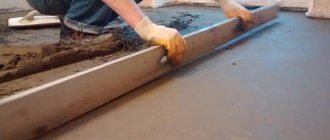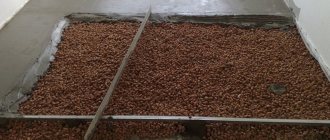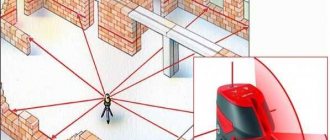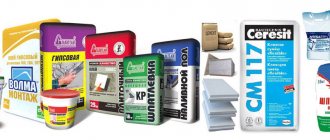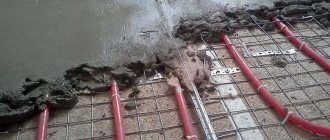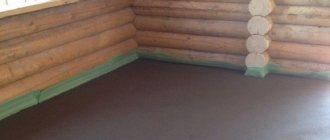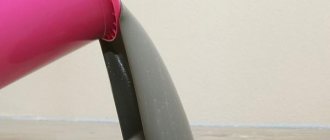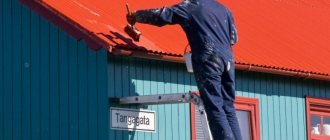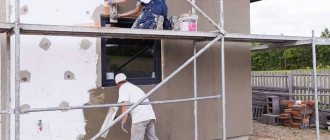Most of those who start renovations are not professional builders. And thanks to the availability of information, it has become easier to carry out repair work with less financial losses. Why renovation begins, of course, with leveling the floors, this is especially true for old buildings, where screeding is required. So what is the cement consumption per 1m2 of screed?
One of the main components required for screeding is cement. The main problem when working with it is the low shelf life after opening the package. Over time, cement cakes and loses its properties. Therefore, it is necessary to purchase this material right before use and preferably the exact quantity.
To do this, you need to carry out preliminary calculations to calculate how much cement will be needed for the entire quadrature where the screed will be carried out. The correct numbers will help save you money and minimize the loss of materials.
Several factors must be taken into account to ensure that the finished surface can withstand future loads. If you use little cement, then after drying the screed will begin to crumble or crack. By increasing the amount of cement in the finished mortar, the floor will be much stronger, but this will hit your pocket.
How to correctly calculate the cement consumption per 1 m2 of screed? It is necessary to take into account many nuances, which we will consider below.
Properties of the screed
When doing all the work on screeding floors yourself, for example, for a home, it is necessary, before starting work, to carry out all possible calculations.
A typical floor screed mortar consists of sand, cement and water; sometimes additional ingredients are added to the mixture to improve strength: enhancers and fillers that help increase the strength of the finished base.
Here are the most important functions of the screed:
- the finished structure allows you to level the surface in order to subsequently lay finishing materials on it: linoleum, laminate, parquet;
- additional protection from extraneous sounds: noise in the process of life, yours or your neighbors; noises from impacts or air;
- improving thermal insulation in the room;
- masking of pipeline communications or engineering manipulations;
- If the house has a built-in heat pipe, the screed ensures uniform heat distribution.
Why is the screed calculated?
A screed is a mixture of cement and sand designed to cover and level the base before laying finishing elements. In addition to the leveling function, the screed hides communication nodes inside itself; floor hydro- and thermal insulation is laid directly on the screed.
There are several purposes for screeds:
- Covering for technical purposes that remains final, such as a garage floor;
- An intermediate element for further installation of finishing materials;
- The screed, carried out as a continuous covering, fills the floor of the entire room and leveling occurs;
- The use of a self-leveling mortar has high fluidity and requires a sealed base.
Due to its fluid structure, no leveling step is required.
Types of screeds
The screed is divided into several types.
Structural
- in one continuous layer;
- in several layers (thermal insulation, waterproofing, sound insulation, etc.)
Structural
Composite
- made of concrete;
Made from concrete
- cement-sand;
Cement-sand
- screed mortar using synthetic resins;
- made of plaster;
From plaster
- screed using mosaic , laid on top of concrete.
Mosaic
By type of fastening of screeds with slabs
- screed that is connected directly to the base;
- screed located on the dividing waterproofing layer;
- floating screed laid on top of hydro- and sound-proofing materials
For each type of screed, you must use your own calculations:
- the brand of cement material used,
- its quantitative consumption per 1m2
- individual technology for mixing cement mixture.
If the technology is violated, the screed can peel off, become covered with cracks and even fall out in large pieces, not to mention the formation of voids.
Heated floor screed solution
It was said above that floor screed, in addition to the function of leveling the surface, can be used as insulation. In this case, the composition of the mortar for constructing the structure will be different. In this case, “warm” materials are added to the solution.
The most budget-friendly but effective option is to add sawdust and lime to the cement-sand mortar. There are three types of mortar recipes for warm screed:
- High density, kg: 1 part cement, 1 part sawdust, 1.5 parts sand, 0.25 parts lime.
- Average density, kg: 1 part cement, 1.3 parts sawdust, 2.3 parts sand, 0.6 parts lime.
- Low density, kg: 1 part binder, 4 parts sawdust, 1 part sand, 2 parts lime.
How to calculate cement for a floor covered with a warm screed? In this case, you should set the amount of cement in kilograms and calculate the amount of other components in accordance with the given proportions.
What materials are required for floor screed?
To begin preliminary calculations, it is worth deciding in which room the screed will be carried out. Because cement has different properties due to its composition.
If you plan to lay porcelain tiles in the room or this is an office space, you will need to use cement with high-strength properties. The reason for this is the pressure exerted on the floor.
To screed floors in a residential building, you can use GOST 31108 cement of medium strength; only in recent years, the demand for material with a coefficient below M300 has practically fallen. Therefore, its production has decreased. Because of this, the M400 cement grade is most often used. But what does this mark mean on the product?
- M 400 - indicates the ability to withstand pressure of 40 tons per 1 m3;
M-400
- if the designation “D” , then it means the presence in percentages of various additives that increase the resistance of the finished screed to cold and moisture;
With additives
- the designation “GF” indicates how much the material is afraid of moisture, hence the place of its storage is taken into account.
But not only cement is used for screed; sand is another important component. It must be calculated in the ratio of 1 kg of cement 3 kilograms of sand.
Floor screed reinforcement
Screed reinforcement is not a mandatory process and is usually performed in the following cases:
- When the screed is laid on a base subject to bending and stretching. An example would be the installation of a multi-layer floor structure, where the screed is located above a heat-insulating layer of mineral wool, polystyrene foam or sound-proofing materials.
- When using backfill (sand, expanded clay, crushed stone) to raise the floor level, it is also recommended to reinforce the screed.
- When it is necessary to strengthen the screed in places of increased load (under stoves, fireplaces, in the garage).
- When a screed thickness of more than 50 mm is performed.
The main materials for reinforcement are:
- Metal reinforcing mesh. With their help, the most durable coating is created. This is due to the presence of a frame capable of distributing loads in screed structures and protecting them from destruction during bending.
- Polymer, fiberglass and composite reinforcing meshes are weaker in tensile strength than metal ones, so they are used for unloaded screeds (floors in apartments and private houses).
- The third common reinforcing component is fiber. Fiber in the form of fibers can be made of metal, polypropylene, basalt fiber or fiberglass. A screed with fiber mixed into the solution protects against cracks and shrinkage, but cannot resist high tensile and bending stresses.
A common type of fiber is propylene fibers of a translucent white hue, having a diameter of 15 - 25 microns. The proportions of its addition to the solution depend on the requirements for the screed:
| Fiber consumption | Characteristics of the screed |
| 300 g per cubic meter m | Minimum allowable consumption. This amount slightly improves the quality of the screed (binding function) and makes it easier to work with the material. |
| 600 g per cubic meter m | The ductility, resistance to moisture penetration, strength and service life of the coating are significantly increased. |
| 800 to 1500 g per cubic meter m | Maximum efficiency is achieved. |
Typically, screeds in houses and apartments are installed on existing reinforced concrete slabs. Such a base does not allow tensile loads to occur, leading to deformations. Accordingly, in this case there is no need for reinforcing reinforcement - the screed without additional inclusions will perfectly cope with its functions.
Preliminary measurements of room floors before starting cement and sand calculations
- To determine the exact consumption of sand and cement per 1 m2 of screed, you must accurately measure the area of the room in which you plan to screed the floor.
- The room must first be cleared of all foreign objects, including debris and dust, so that nothing affects the measurement results. After this we move on to measuring the floor.
- Initially, the zero level of the mark is determined; it can be located in any part of the room. To do this, you will need a laser tool or spirit level, then mark each wall of the room from the found point.
- The next step is to connect all the marks with one straight line . This is how the level of height difference is determined; it should not exceed five centimeters. The thickness of the screed at the highest point of the room must be at least 8 mm. If the differences are too critical, you should first level the most uneven areas.
Otherwise, after completing the screed with sharp changes in the level of layer thickness, the surface will become covered with cracks and will crumble.
Cement-sand mixture for floor screed, consumption of CPS per 1 m2 of screed
Floor screeding is done in order to obtain a flat base for floor coverings. A solution of sand and cement is considered reliable and cheap. However, builders recommend using this mixture in single-story buildings or structures with strong interfloor ceilings, since the hardened mortar has a lot of weight and can affect the structure of the building. To prevent this from happening, you should follow the proportions and calculate the consumption of DSP for floor screed.
Screed mortar - how to calculate the consumption and amount of cement on a calculator
There is no standard formula that would calculate the exact volume of cement material required for a screed.
Each builder uses his own calculation system, and it must be taken into account that it is different for different brands of cement.
So, for example, to use the M400 or M500 brand, the required proportions for floor screed in a residential building are 1:3.
The required value of cement consumption is calculated from the product:
- room length;
- thickness of the screed layer;
- area of the room.
To the obtained value it is necessary to add about a quarter of the calculated amount of materials. Because the finished cement mortar gives sediment. If you decide to use ready-made mixtures, then the approximate consumption volume will be 17-20 kg per 1 m2, taking into account that the permissible thickness of the screed will be 1 cm.
What will be the consumption of mortar per 1 m2 of screed with a thickness of 30 mm? For example, let’s take a room area of 12 m2. The grade of cement used is M400. Now let’s calculate the volume consumption of the finished solution:
- 12 * 0.03 = 0.36 m3,
Let's calculate what the cement consumption will be for a given area. According to the standards, 410 kg of cement of a specific brand is used per 1 m3:
- 410 * 0.36 = 147.6 kg. Or 3 bags of standard packaging of 50 kg.
We also calculate the required amount of sand and water for the solution:
We take the proportions 1:3, which means you will need 9 bags of sand, with the same weight. For every kilogram of solution, 0.2-0.5 liters of water is required, which means that for the entire volume of the solution you will need:
- 147.6 * 0.2 = 73.8 liters.
The dry solution should be mixed thoroughly before adding water. It should also be mixed immediately before applying to the floor. In this case, a trowel and shovel are used.
When mixing, the dry components of sand and cement decrease in volume due to water, therefore the final mass of the solution is much lower.
It should be taken into account that 1 liter of ready-made solution requires approximately 1.5 kg of cement. This means that from one bag you will get only 36 liters of the finished mixture. That is why another 25% of dry material is added to the final calculated figures.
If you want to further strengthen the screed, add PVA glue to the solution; it will act as a plasticizer.
For more information on how to prepare a screed solution, watch the video:
Water-cement ratio of cement-sand screed
Cement-sand screeds can be divided into the classic type, widely used in private construction, and professional semi-dry coatings. The main difference between semi-dry screed and classic wet screed is the amount of water. When mixing the solution, it is added almost twice as much as for a wet screed. At the same time, this amount of water is just enough for hydration and gaining brand strength.
Due to the limited water-cement ratio (0.35 - 0.43), it will be difficult to produce a large volume of semi-dry screed using a conventional gravity concrete mixer. Typically, specialized mortar pumps are used for these purposes, which not only forcibly mix the mixture, but also deliver it to the installation site.
If the volumes are small or it is not possible to use bulky equipment, a hand-made semi-dry or wet screed is the way out. The water-cement ratio of a classic screed is 0.48 - 0.55.
The peculiarity of the water-cement ratio is that it is calculated only from the mass of cement. For example, to produce M300 concrete, 100 kg of cement will require 100 × 0.53 = 53 liters of water. But working with the proportions of concrete and mortars, we move on to volumetric indicators. And in this case, 100 kg of cement ≈ 0.07 m³. Multiplying as follows: 0.07 m³ × 0.53 = 0.037 m³ water - you will get an error. How to avoid this is described below in the example of calculating the components of a floor screed.
Additional nuances
Screed is a special type of mortar that requires certain standards and ingredients. It is necessary to strictly observe the proportions so that the finished screed is of good quality. Strictly follow the requirements for material consumption. Saving cement can have negative consequences.
Today, river sand is rightfully the most effective building material. Here are the density characteristics of this material.
Deep penetration primer is designed to give the surface ideal evenness, smoothness and better adhesion between the finishing material and the primer. Here you will learn about the different types and technologies for using primers.
Wall panels for interior decoration appeared not so long ago, but have already gained popularity among the population. By clicking on the link, you will become familiar with the materials and areas of application of the panels.
Basic calculations of proportions are carried out on a calculator after taking into account all the data about the room.
It is necessary to correctly calculate the area of the room and the height of the layer. This data will help you clearly determine the required amount of dry material for the screed.
During work, various cement grades can be used, and each has its own material consumption shown in the table:
Mixture composition
The traditional brand used for floor screed is M200 from the M400 category. If the screed is not laid evenly, then during the drying process it will become covered with cracks; in order to avoid this, the place where small cracks appear must be moistened with water.
Standard plaster consumption rates
Average values allow you to estimate material costs:
- For a cement-sand composition, the average cost per square meter when leveling with a layer of 10 millimeters is 17 kilograms. When working on beacons - up to 30 kilograms.
- When working with gypsum mixture, the average is lower. It makes up 8-9 kilograms of the mixture.
- When working with decorative plaster, the consumption ranges from 2 to 4 kilograms.
Each manufacturer’s packaging indicates the value that goes into finishing 1 m2 with a thickness of 1 centimeter.
For a cement-sand composition, the average cost per square meter is 17 kilograms
Consumption of plaster mortar per 1 m2 of wall
To calculate the required plaster, you need to know the average consumption rate of a particular manufacturer. For the “Moment” cement mixture it is 17 kilograms.
To level the base with a difference of 2.5 centimeters, you will need 17x2.5 = 42.5 kg.
Knowing the volume of the entire area and the weight of the bag, it is easy to calculate how much volume is required for the entire job.
Consumption of plaster by type or manufacturer
There is a wide variety of manufacturers of building mixtures on the market. Among the most famous and trusted:
- "Knauf";
- "Rotband";
- "Berhauf".
The average consumption is indicated on each package.
So, for Knauf cement plaster it is 8 kilograms. Bags are packed in 30 kg bags. Considering these indicators, one bag is enough to finish 3.7 (30:8 = 3.7) m2 with a thickness of 1 centimeter.
One of the most famous manufacturers of building mixtures is Knauf
For Bergauf plaster, the average is 16 kg per m2. Packaging is 25 kg. Thus, one package is enough for 1.6 m2 of base.
For Bergauf plaster the average consumption is 16 kg per m2
A similar calculation is easy to carry out for any type of finishing coating if the thickness of the layer, the average consumption of material and the weight of the packaging are known.
Step-by-step instructions for preparing a cement-sand mixture
The work itself is not as difficult as calculating the proportions for the finished solution. Ideally, the work should be done in pairs. While you are leveling the screed, your partner is making a new batch of mortar.
It is advisable to screed one room at a time, because uneven drying of the mortar will lead to the formation of cracks or inconsistencies in level.
So, instructions for performing floor screed:
- At the first stage, it is necessary to clear the room of everything unnecessary, including garbage. A hard broom, brush or vacuum cleaner is suitable as a handy tool.
Cleaning the premises
- Fill cracks , if any, so that the solution does not go to waste. Here it is better to use polyurethane foam.
Puttying cracks
- After completing the preliminary work, we move on to marking the floor and installing beacons. It is imperative to determine the highest points of the floor, because the thickness of the layer in this place must be at least 0.8 mm, otherwise the screed here will begin to crumble.
- as marks . Screw one in at the highest point, leaving the cap on the surface as a beacon. We do the same with other notations. Then check the evenness of the level by placing a ruler on the screws; if there are inaccuracies, they can be easily corrected by adjusting the screw.
Installation of beacons
- After placing the beacons, we begin mixing the solution . To do this, you must have calculated in advance the required amount of material. Before applying the solution to the base, it must be thoroughly moistened with water, of course not to the point of puddles, but thoroughly.
Preparation of the solution
- This way the adhesion to the base will be much better. As you work, you need to additionally treat the dried surface with water before laying the solution. If desired, the builder can pre-prime the base.
- The next stage is pouring the solution. You need to fill from the far corner of the room opposite the exit. Otherwise you will have to walk on the screed. After pouring, they begin to level the surface using the rule, focusing on the placed beacons.
Filling and Alignment
- After finishing pouring, cover the surface with plastic wrap for 12 hours.
- After curing for 12 hours, you can begin to grout the surface.
Grout
- All beacons can be removed, and the remaining marks can be sealed with the same solution so that there are no flaws left.
By following the basic rules when screeding, you will quickly get the job done.
Plasticizers for cement-sand mortar
It is impossible to increase the plasticity of mixtures by increasing the amount of water, since a change in the water-cement ratio will inevitably lead to a decrease in the specified strength of the solution, as well as the formation of shrinkage cracks. For these purposes, it is recommended to use special additives - plasticizers, produced in different forms (liquid, powder).
Plasticizers for concrete are divided into:
- Hydrophilic - reacting with water, which is found in all concrete mixtures. As a result of the chemical process, an astringent and fluid composition is formed. Once in the concrete solution, the plasticizer binds water molecules, which turns into a viscous mixture that interacts with cement, crushed stone and sand.
- Hydrophobic and hydrophobizing - during the hardening process, they push water out of the composition. The operating principle is based on saturating the mixture with microscopic air cavities, which in turn increases the insulating properties of the finished structure, removes excess moisture, and reduces the possibility of freezing of the poured solution.
One of the most common modifications of super plasticizers for increasing the mobility of concrete and mortar mixtures, accelerating setting and strength gain is C-3.
Plasticizers
Plasticizer S-3 is available in the following forms: powder and liquid. The product contains sulfonated polycondensates and sodium sulfate.
Being universal, this additive is widely used for:
- Increasing the plasticity of the mixture.
- Increasing frost resistance.
- Improvements in cement hydration.
- Reducing the concentration of air pores.
Consumption of plasticizer S-3:
| Type of plasticizer S-3 | Consumption, kg / 100 kg of dry cement | Application |
| Liquid | 0,6 — 1,2 | moving concrete for the construction of walls and ceilings, pouring floors, installing screeds |
| Dry | 0,2 — 0,4 | |
| Liquid | 1,2 — 2,4 | self-compacting concrete for pouring foundations, monolithic structures, complex reinforced concrete structures |
| Dry | 0,4 — 0,8 |
Procedure for using plasticizer S-3:
- The liquid plasticizer solution is thoroughly mixed and added to water to dissolve.
- Water with a plasticizer is poured into a running concrete mixer. Measure out the required amount of cement and load it into a concrete mixer. Add solid aggregate and bring the solution to readiness.
- When using powdered plasticizer C-3, you must first prepare a 35% aqueous solution of plasticizer (approximately 1 part plasticizer to 2 parts water).
Floor screed - material consumption per 1 sq. m.
Various types of screed are still the most popular way to level the floor before laying the final decorative floor covering. Proper organization of work on their installation requires an accurate calculation of the amount of materials required to prepare the required volume of the mixture to be laid. That is why it is extremely important for the contractor to be able to calculate the consumption of the solution and the initial components for mixing it per 1 square meter. m of finished screed.
The importance of correctly determining the amount of materials needed.
The need for preliminary calculation of material consumption per 1 sq. m. and, as a result, there are no questions about the entire volume of the screed, since the results obtained are influenced by more than just several important parameters. These include:
- cost of the screed device. Costs for materials are one of the main cost items, constituting a significant share in the total price of the work performed;
- quality of solution preparation. The correct dosage of individual components when mixing is of great importance for obtaining a finished mixture with the required performance properties;
- continuous production of work. Proper organization of construction requires the availability of the required amount of materials at the site so that workers do not have to wait for the delivery of the missing cement, sand, fiberglass or ready-made cement-sand mixture and stop work and the technological process because of this.
